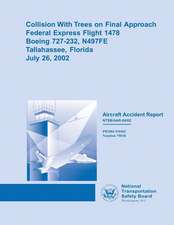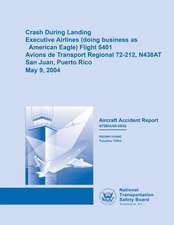Bigelow Aerospace: Colonizing Space One Module at a Time: Springer Praxis Books
Autor Erik Seedhouseen Limba Engleză Paperback – 13 oct 2014
- how a space technology start-up is pioneering work on expandable space station modules
- how Robert Bigelow licensed the TransHab idea from NASA, and how his company developed the technology for more than a decade
- how, very soon, a Bigelow expandable module will be docked with the International Space Station.
Din seria Springer Praxis Books
-
 Preț: 294.46 lei
Preț: 294.46 lei -
 Preț: 223.45 lei
Preț: 223.45 lei -
 Preț: 193.12 lei
Preț: 193.12 lei -
 Preț: 167.85 lei
Preț: 167.85 lei -
 Preț: 288.98 lei
Preț: 288.98 lei -
 Preț: 323.74 lei
Preț: 323.74 lei -
 Preț: 401.38 lei
Preț: 401.38 lei -
 Preț: 264.12 lei
Preț: 264.12 lei - 8%
 Preț: 513.00 lei
Preț: 513.00 lei -
 Preț: 190.01 lei
Preț: 190.01 lei -
 Preț: 218.16 lei
Preț: 218.16 lei -
 Preț: 312.06 lei
Preț: 312.06 lei - 17%
 Preț: 414.04 lei
Preț: 414.04 lei -
 Preț: 216.41 lei
Preț: 216.41 lei -
 Preț: 262.27 lei
Preț: 262.27 lei -
 Preț: 264.35 lei
Preț: 264.35 lei -
 Preț: 167.63 lei
Preț: 167.63 lei -
 Preț: 284.81 lei
Preț: 284.81 lei -
 Preț: 259.08 lei
Preț: 259.08 lei -
 Preț: 305.47 lei
Preț: 305.47 lei -
 Preț: 244.14 lei
Preț: 244.14 lei -
 Preț: 227.85 lei
Preț: 227.85 lei -
 Preț: 285.25 lei
Preț: 285.25 lei -
 Preț: 295.56 lei
Preț: 295.56 lei -
 Preț: 357.17 lei
Preț: 357.17 lei -
 Preț: 275.79 lei
Preț: 275.79 lei -
 Preț: 257.08 lei
Preț: 257.08 lei -
 Preț: 349.71 lei
Preț: 349.71 lei -
 Preț: 272.45 lei
Preț: 272.45 lei -
 Preț: 270.27 lei
Preț: 270.27 lei - 8%
 Preț: 456.51 lei
Preț: 456.51 lei -
 Preț: 352.34 lei
Preț: 352.34 lei - 8%
 Preț: 394.80 lei
Preț: 394.80 lei -
 Preț: 320.65 lei
Preț: 320.65 lei -
 Preț: 325.29 lei
Preț: 325.29 lei -
 Preț: 253.11 lei
Preț: 253.11 lei -
 Preț: 192.86 lei
Preț: 192.86 lei -
 Preț: 313.40 lei
Preț: 313.40 lei -
 Preț: 150.51 lei
Preț: 150.51 lei -
 Preț: 233.34 lei
Preț: 233.34 lei -
 Preț: 286.78 lei
Preț: 286.78 lei -
 Preț: 212.01 lei
Preț: 212.01 lei -
 Preț: 366.83 lei
Preț: 366.83 lei -
 Preț: 299.99 lei
Preț: 299.99 lei -
 Preț: 232.27 lei
Preț: 232.27 lei -
 Preț: 284.58 lei
Preț: 284.58 lei -
 Preț: 212.45 lei
Preț: 212.45 lei -
 Preț: 159.81 lei
Preț: 159.81 lei -
 Preț: 349.48 lei
Preț: 349.48 lei - 20%
 Preț: 2061.61 lei
Preț: 2061.61 lei
Preț: 318.44 lei
Nou
Puncte Express: 478
Preț estimativ în valută:
60.93€ • 63.79$ • 50.42£
60.93€ • 63.79$ • 50.42£
Carte tipărită la comandă
Livrare economică 05-19 aprilie
Preluare comenzi: 021 569.72.76
Specificații
ISBN-13: 9783319051963
ISBN-10: 3319051962
Pagini: 182
Ilustrații: XIX, 182 p. 66 illus., 59 illus. in color.
Dimensiuni: 168 x 240 x 10 mm
Greutate: 0.34 kg
Ediția:2015
Editura: Springer International Publishing
Colecția Springer
Seriile Springer Praxis Books, Space Exploration
Locul publicării:Cham, Switzerland
ISBN-10: 3319051962
Pagini: 182
Ilustrații: XIX, 182 p. 66 illus., 59 illus. in color.
Dimensiuni: 168 x 240 x 10 mm
Greutate: 0.34 kg
Ediția:2015
Editura: Springer International Publishing
Colecția Springer
Seriile Springer Praxis Books, Space Exploration
Locul publicării:Cham, Switzerland
Public țintă
Popular/generalCuprins
Robert T. Bigelow, Orbital Real Estate Mogul.- Expandable Module Technologies.- TransHab Close.- Genesis I and II.- Bigelow Expandable Activity Module.- The Space Taxi Race.- Bigelow's Space Station.- The Man Who Sold the Moon.
Recenzii
“Robert Bigelow has made a very large fortune in property and hotel chains. … This excellent book is a great primer on the man, his company and a myriad of ideas all the way to bases on Mars.” (Spaceflight, Vol. 58 (3), 2016)
Notă biografică
Dr. Erik Seedhouse worked as an Astronaut Training Consultant for Bigelow Aerospace in 2005, a company for whom he wrote the Spaceflight Participants Flight Surgeon’s Manual. He also developed astronaut-training protocols for future spaceflight participants and wrote and edited several chapters of Bigelow Aerospace’s Astronaut Training Manual. Erik is a research scientist specializing in environmental life sciences and physiology, the subject in which he obtained his Ph.D. in Physiology while working for the European Space Agency between 1996 and 1998. In 2009, he was one of the final candidates for selection as an astronaut in the CSA’s Astronaut Recruitment Campaign. He is a certified commercial suborbital astronaut who will fly a payload mission in 2014. He is also Training Director for Astronauts for Hire and, for the last four years, served as Director of Canada’s Manned Centrifuge Operations.
Textul de pe ultima copertă
Here for the first time you can read:
- how a space technology start-up is pioneering work on expandable space station modules
- how Robert Bigelow licensed the TransHab idea from NASA, and how his company developed the technology for more than a decade
- how, very soon, a Bigelow expandable module will be docked with the International Space Station.
Caracteristici
Describes the technology of inflatable modules and how establishing these habitats in orbit could generate an orbital economy Explains the details of one of the foremost emerging private space exploration ventures Offers informed speculation on possible lunar and Martian bases that the future may hold Includes supplementary material: sn.pub/extras


















